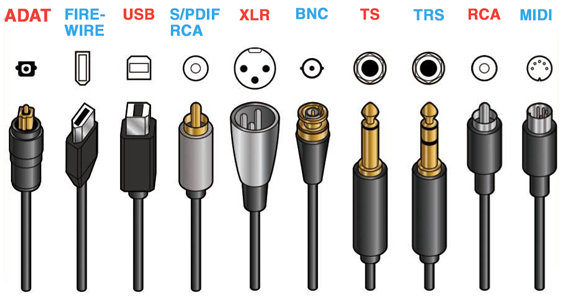What Audio Cable Is Best?
In this article we explain how to choose the best audio cable, what’s the difference between one and the other and a bit of history behind each of them. Understanding audio cables can have a great impact on your sound.

The ADAT Lightpipe is an optical interface for the digital transportation of multiple audio streams. Developed in the late 80’s by American company Alesis, the ADAT (Alesis Digital Audio Tape) protocol has been embraced by different manufacturers over the years and it’s now considered a standard in professional digital audio.
More info on: https://en.wikipedia.org/wiki/ADAT_Lightpipe

The FireWire (IEEE 1394) standard was brought by Apple at around the same time and it’s a serial interface. It’s widely used to connect various types of devices to a computer but it’s also widely used to transport digital audio, especially from and to audio interfaces. It comes with 2 types of connectors: a 6-conductor FireWire 400 alpha connector or a 9-pin FireWire 800 connector. With the introduction of Thunderbolt, this interface is becoming less and less popular.
More info on: https://en.wikipedia.org/wiki/IEEE_1394

USB stands for Universal Serial Bus and it’s arguably the most used connection in audio for its speed, reliability and availability. Most audio interfaces are capable of transporting a large number of digital audio streams from and to the computer through this format. USB 3 is at the (time of writing) the fastest version of it, however USB 2 is perfectly OK in most cases.
More info on: https://en.wikipedia.org/wiki/USB
To know more about our Mixing, Mastering and Production services please get in touch with us here.

S/PDIF (IEC 60958) stands for Sony/Philips Digital Interface Format and it’s a consumer type interface for the transportation of stereo digital audio signals. It was developed on the 90’s and it typically uses standard coaxial RCA connectors.This type of interface is based on AES/EBU standard and sometimes it’s used with fibre optic cables, often through a TOSLINK connector.
More info on: https://en.wikipedia.org/wiki/S/PDIF

Three-pin XLR cables are used to carry analogue balanced audio. This is the most reliable and clean to connect professional audio gear. Balanced audio allows to stretch cables across long distances without significant added noise. This happens through the clever use of 2 different signals being transported inside the cable, one in-phase and one out-of-phase, so that external interferences can be nulled.
In addition to the audio signal, hey can also carry a low voltage (48v known as phantom power) to power condenser microphones and DI boxes.
XLR cables are also used for lighting, amplified signals and power transportation and they can have up to 7 pins. However thy are most commonly used in their 3 pin configuration for microphones and line level signal (typically at +4 dBu).
More info on:
https://en.wikipedia.org/wiki/XLR_connector
https://en.wikipedia.org/wiki/Balanced_audio
https://en.wikipedia.org/wiki/Phantom_power
https://en.wikipedia.org/wiki/Line_level

BNC stands for Bayonet Neill–Concelman and it’s a type of connector used for radio frequencies. In audio these are typically used to synchronise the sample clock between different digital devices. The signal that passes through a BNC connector (for this use) is called word clock and it’s used in conjunction with AES/EBU or S/PDIF connection to improve stability and sample accuracy.
More info on:
https://en.wikipedia.org/wiki/BNC_connector
https://en.wikipedia.org/wiki/Word_clock

The TS (Tip and Sleeve) 1/4 inch (6.3mm) jack plug is one of the most common connectors in audio and it was first developed for telephone switchboards in the early 20th century. It’s used to carry analogue unbalanced mono signal and its considered a standard for electric bass & guitars, synthesisers and other generic audio gear. It’s sturdy, reliable and durable: these are some of the reasons behind its extraordinary longevity.
More info on: https://en.wikipedia.org/wiki/Phone_connector_(audio)

The TRS (Tip, Ring and Sleeve) is a variation of the TS and it’s used for balanced or stereo line audio signals. Typically used on mixers and outboard gear, the TRS jack plug is the standard connection for professional and consumer headphones. A 3.5mm version of the TRS is the omnipresent stereo mini jack, which became popular in the 80’s with the success of the Sony Walkman cassette players, and it’s still used today on most portable audio players on the market today.
More info on: https://en.wikipedia.org/wiki/Phone_connector_(audio)

The RCA (Radio Corporation of America) connector is a consumer standard firstly introduced in the 40’s. It’s typically used in pairs to carry analogue unbalanced signals at −10 dBV line level or for turntables (phono). It’s usually associated with Hi-Fi systems, DJ equipment and up until recently for video. However the more modern digital video standards such as HDMI have made the RCA connectors redundant for video applications.
More info on:
https://en.wikipedia.org/wiki/RCA_connector
https://en.wikipedia.org/wiki/Line_level

The MIDI (Musical Instrument Digital Interface) connector is a five-pin DIN plug used for synthesisers and computers to communicate the pitch and velocity of notes being played on a keyboard. This protocol also transmits other information such as vibrato, volume and assignable controllers across 16 channels. This technology was developed and standardised by a group of international manufacturers in the early 80’s, including Roland, Oberheim, Yamaha, Sequential Circuits and Kawai. Although most modern keyboards use USB to connect to computers, the MIDI connector is still widely used and present on most synthesiser, especially for live applications.
More info on:
https://en.wikipedia.org/wiki/DIN_connector
https://en.wikipedia.org/wiki/MIDI
– See more at: http://www.doctormix.com/blog/what-audio-cable-is-best#sthash.ZEOi5vcy.dpuf
Julian Ludwig é diretor do Pro Áudio Clube, produtora de áudio Jacarandá, Loc On Demand e Jacarandá Licensing. Trabalhou para empresas como: Guaraná Antartica, TV Gazeta, NET, Chivas Regal, FNAC, Prefeitura de São Paulo, Mukeca Filmes, Agência LEW’LARA TBWA, Agencia MPM, Agência Content House entre outras. Fez trilhas para programas de TV como: Internet-se (Rede TV), Você Bonita (TV Gazeta), Mix Mulher (TV Gazeta), Os Impedidos (TV Gazeta), Estação Pet (TV Gazeta), CQC (TV Band) Vinheta Oficial TV Gazeta, entre outras. Também atuou em vários longas e curtas metragens, incluindo mixagem em 5.1 e serviços de pós-produção.

